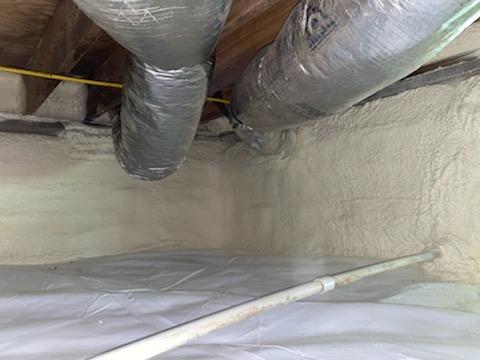Patented & proven solutions
Damp? Musty? Humid? Get a dry, healthy crawl space today!
Get a free estimateBefore & After Photos
Click on a photo to enlarge.
Spray Foam - Richmond Crawl Space Encapsulation
Spray Foam insulation is installed on the crawl space walls and the vents, rim & band, and sill plate are sealed and insulated.
Installing a Vapor Barrier in Chester, VA
The standard vapor barrier that is installed in the crawl space during construction is a flimsy 6-mil liner that is easily torn apart by any service persons, rodents, and pests who crawl on top of it. This ineffective vapor barrier does not get properly sealed around the piers or foundation walls. Moisture from the earth floor rises into the crawl space through these gaps, adding to the relative humidity if the temperature rises.
CleanSpace is a 20-mil thick vapor barrier that completely seals off the home from the earth’s moisture. It is wrapped around the piers and sealed to the foundation walls using a 4” wide vinyl tape. Moisture rising from the ground is not able to penetrate the CleanSpace liner, adding to the total control of relative humidity in the crawl space.
Vented Crawl Space in Chester, VA
The open vents allow moisture and outside air into the crawl space. This makes it extremely difficult to control the overall relative humidity underneath a home. The dry winter air entering the vents will cause the floors above to feel cold and drafts, as well as raising the energy costs to keep the house comfortable. And in the summer, the wet, hot air will carry moisture into the crawl space, raising the relative humidity and allowing mold and mildew to thrive.
The foundation walls of this crawl space have been sprayed over, using a closed-cell spray foam that provides not only insulation but blockage from outside air moisture, while the open vents were sealed with foam board and covered in the same closed-cell spray foam. When closed-cell spray is applied at 1.5” thickness, it acts as an air barrier and vapor retarder. Sealing off the outside air and moisture provides the homeowner with more control over the relative humidity in the crawl space.
Crawl Space Foundation Walls in Chester, VA
The insulation in this crawl space beginning to pull apart and fall to the floor. Fiberglass insulation is not meant to hold moisture, and it loses its value when it becomes damp. Water droplets displace the air in the spaces between the glass fibers, reducing the material's thermal abilities. The wet insulation fibers pull apart and the added weight of moisture causes it to sag and even fall to the crawl space floor, rendering it useless.
Most crawl spaces in our area, like this Chester, VA home have fiberglass insulation between the floor joists. However, this is not an effective solution in our area due to high humidity and warm temperatures over half of the year resulting in high relative humidity, falling insulation, and microbial growth. So instead, the foundation walls were insulated using closed-cell spray foam which acts as an air barrier and vapor retarder, while the home was sealed from the earth’s moisture with CleanSpace, a heavy-duty vapor barrier. The foundation vents were sealed with Foamax foam board and covered over with closed-cell spray foam. Not only does all this protect the crawl space from moisture, with the addition of a dehumidifier it helps control the relative humidity, improves air quality, and reduces energy bills.
Crawl Space Encapsulation in Bruington, VA
This Bruington, VA client contacted us about repairing moisture damage in their crawl space. Moisture had caused mold and mildew growth, was absorbed in the insulation which held it against the floor joists, the material began to delaminate and fall away from the floor.
All debris and insulation was removed from the crawl space, microbial growth was treated, the vents, sill plate, & rim band were sealed, the foundation walls were insulated with closed cell spray foam insulation and a dehumidifier was installed to control the relative humidity. The homeowners no longer need to worry about moisture damage in their crawl space and have the added benefit of warmer floors in the winter and reduced drafts in the home.










